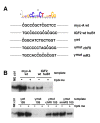Allele-specific transcriptional elongation regulates monoallelic expression of the IGF2BP1 gene
- PMID: 21812971
- PMCID: PMC3174113
- DOI: 10.1186/1756-8935-4-14
Allele-specific transcriptional elongation regulates monoallelic expression of the IGF2BP1 gene
Abstract
Background: Random monoallelic expression contributes to phenotypic variation of cells and organisms. However, the epigenetic mechanisms by which individual alleles are randomly selected for expression are not known. Taking cues from chromatin signatures at imprinted gene loci such as the insulin-like growth factor 2 gene 2 (IGF2), we evaluated the contribution of CTCF, a zinc finger protein required for parent-of-origin-specific expression of the IGF2 gene, as well as a role for allele-specific association with DNA methylation, histone modification and RNA polymerase II.
Results: Using array-based chromatin immunoprecipitation, we identified 293 genomic loci that are associated with both CTCF and histone H3 trimethylated at lysine 9 (H3K9me3). A comparison of their genomic positions with those of previously published monoallelically expressed genes revealed no significant overlap between allele-specifically expressed genes and colocalized CTCF/H3K9me3. To analyze the contributions of CTCF and H3K9me3 to gene regulation in more detail, we focused on the monoallelically expressed IGF2BP1 gene. In vitro binding assays using the CTCF target motif at the IGF2BP1 gene, as well as allele-specific analysis of cytosine methylation and CTCF binding, revealed that CTCF does not regulate mono- or biallelic IGF2BP1 expression. Surprisingly, we found that RNA polymerase II is detected on both the maternal and paternal alleles in B lymphoblasts that express IGF2BP1 primarily from one allele. Thus, allele-specific control of RNA polymerase II elongation regulates the allelic bias of IGF2BP1 gene expression.
Conclusions: Colocalization of CTCF and H3K9me3 does not represent a reliable chromatin signature indicative of monoallelic expression. Moreover, association of individual alleles with both active (H3K4me3) and silent (H3K27me3) chromatin modifications (allelic bivalent chromatin) or with RNA polymerase II also fails to identify monoallelically expressed gene loci. The selection of individual alleles for expression occurs in part during transcription elongation.
Figures








Similar articles
-
Epigenetic regulation of Igf2/H19 imprinting at CTCF insulator binding sites.J Cell Biochem. 2003 Dec 1;90(5):1038-55. doi: 10.1002/jcb.10684. J Cell Biochem. 2003. PMID: 14624463
-
CTCF is the master organizer of domain-wide allele-specific chromatin at the H19/Igf2 imprinted region.Mol Cell Biol. 2008 Feb;28(3):1124-35. doi: 10.1128/MCB.01361-07. Epub 2007 Nov 26. Mol Cell Biol. 2008. PMID: 18039862 Free PMC article.
-
CTCF-dependent chromatin bias constitutes transient epigenetic memory of the mother at the H19-Igf2 imprinting control region in prospermatogonia.PLoS Genet. 2010 Nov 24;6(11):e1001224. doi: 10.1371/journal.pgen.1001224. PLoS Genet. 2010. PMID: 21124827 Free PMC article.
-
Epigenetic events regulating monoallelic gene expression.Crit Rev Biochem Mol Biol. 2015;50(4):337-58. doi: 10.3109/10409238.2015.1064350. Epub 2015 Jul 9. Crit Rev Biochem Mol Biol. 2015. PMID: 26155735 Review.
-
Differential 3D chromatin organization and gene activity in genomic imprinting.Curr Opin Genet Dev. 2020 Apr;61:17-24. doi: 10.1016/j.gde.2020.03.004. Epub 2020 Apr 13. Curr Opin Genet Dev. 2020. PMID: 32299027 Review.
Cited by
-
Chromatin and Genomic determinants of alternative splicing.ACM BCB. 2015 Sep;2015:345-354. doi: 10.1145/2808719.2808755. ACM BCB. 2015. PMID: 28825057 Free PMC article.
-
Insulin-like growth factor 2 mRNA-binding protein 1 (IGF2BP1) in hematological diseases.Mol Med. 2024 Sep 28;30(1):165. doi: 10.1186/s10020-024-00936-2. Mol Med. 2024. PMID: 39342091 Free PMC article. Review.
-
Random monoallelic expression: regulating gene expression one allele at a time.Trends Genet. 2014 Jun;30(6):237-44. doi: 10.1016/j.tig.2014.03.003. Epub 2014 Apr 26. Trends Genet. 2014. PMID: 24780084 Free PMC article. Review.
-
X-Chromosome Inactivation and Autosomal Random Monoallelic Expression as "Faux Amis".Front Cell Dev Biol. 2021 Sep 23;9:740937. doi: 10.3389/fcell.2021.740937. eCollection 2021. Front Cell Dev Biol. 2021. PMID: 34631717 Free PMC article. Review.
-
Perspective: Is Random Monoallelic Expression a Contributor to Phenotypic Variability of Autosomal Dominant Disorders?Front Genet. 2017 Nov 29;8:191. doi: 10.3389/fgene.2017.00191. eCollection 2017. Front Genet. 2017. PMID: 29250101 Free PMC article.
References
-
- Bix M, Locksley RM. Independent and epigenetic regulation of the interleukin-4 alleles in CD4+ T cells. Science. 1998;281:1352–1354. - PubMed
LinkOut - more resources
Full Text Sources
Other Literature Sources
Miscellaneous

